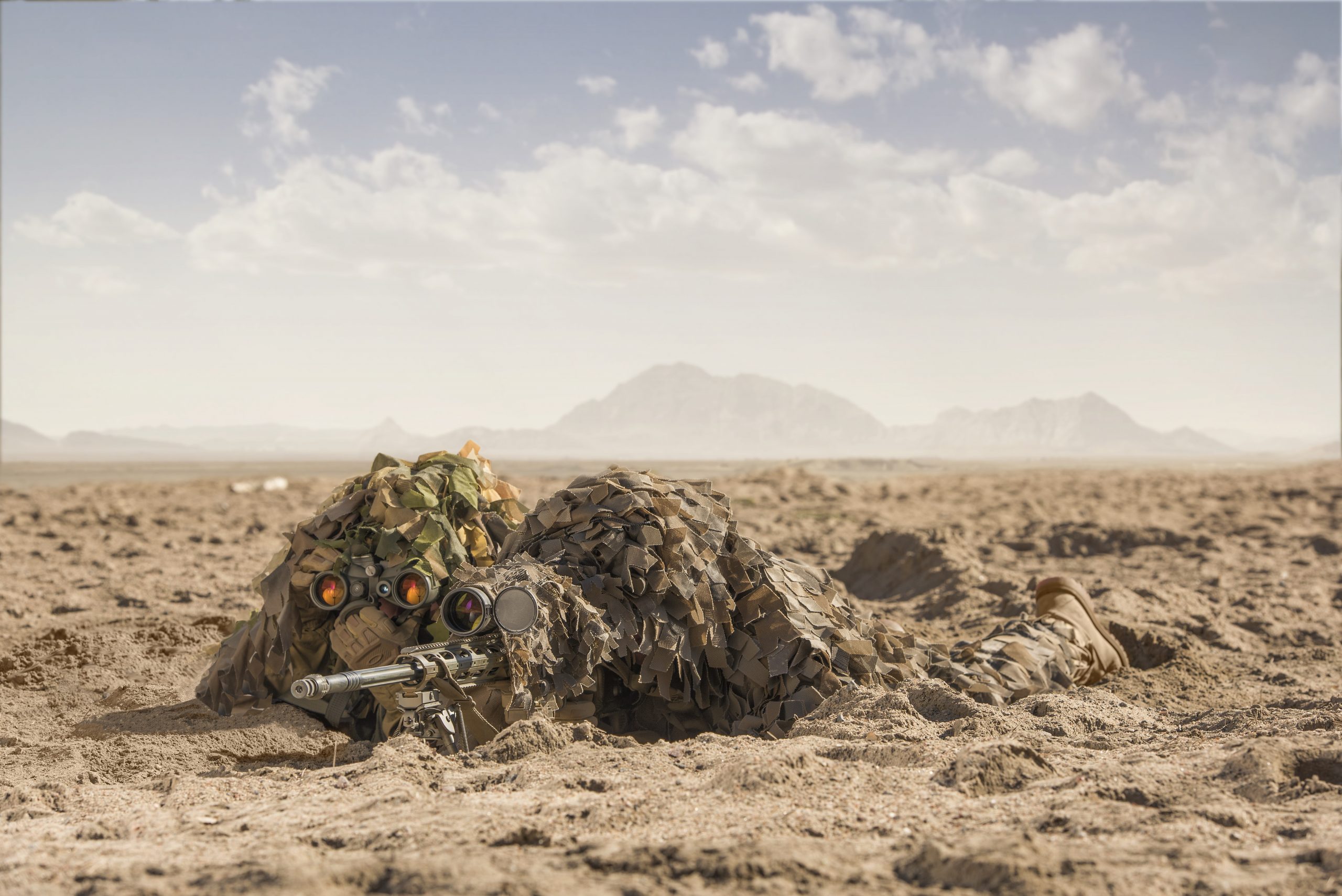
12 June 2023
Tactical Military Gear: A Comprehensive Guide
Tactical military gear refers to equipment, clothing, and accessories designed to enhance the effectiveness and safety of military personnel during combat operations or tactical missions. This comprehensive guide will provide an overview of the essential tactical gear categories BDT can offer and the key items within each category. Keep in mind that specific gear requirements may vary depending on the mission, branch of service, and individual preferences.
Categories of tactical gear:
- protective gear
- firearms, ammunition and accessories
- night vision and optics
- load-bearing equipment
- tactical clothing
- communication and navigation
- medical equipment
- survival and outdoor gear
1. Protective Gear
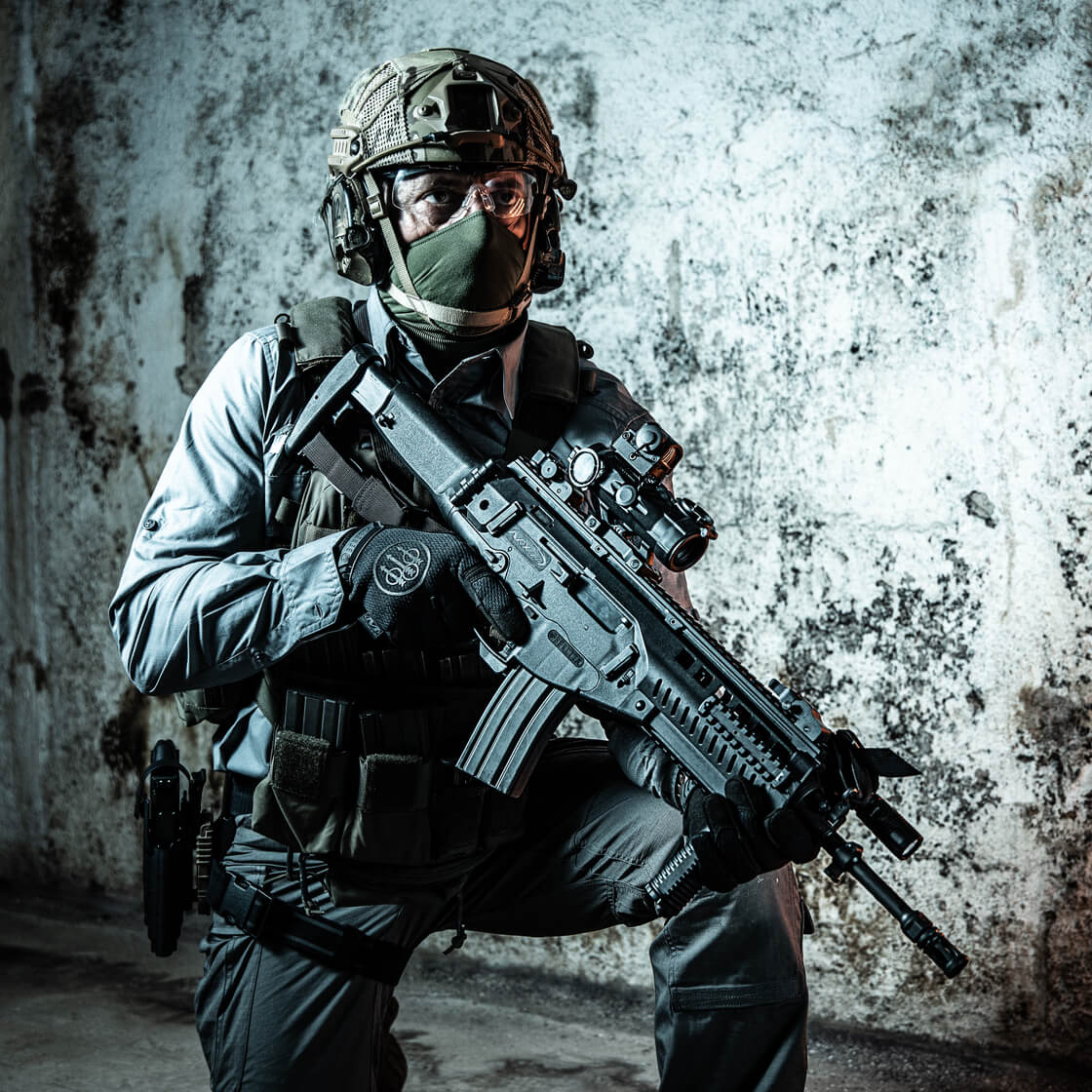
In the context of military gear, “protection” and “survivability” are related concepts but have different implications:
- protection refers to the ability of military gear to shield and safeguard the operator from various threats, preventing or reducing the impact of harm caused by hostile actions or dangerous conditions.
- survivability encompasses a broader set of considerations beyond mere physical protection. It encompasses the ability of military forces or equipment to survive and continue functioning effectively in hostile or challenging environments, despite encountering threats or adverse conditions. Survivability involves factors such as mobility, stealth, redundancy, adaptability, and resistance to disruption. It also includes tactics, training, and operational measures aimed at enhancing the chances of mission success and personnel survival. For example, the wider army’s protective gear is most likely to be fixed, have limited mobility or engage in peer-on-peer close combat on the Forward Line of Own Troops (FLOT) or Forward Edge of Battle Area (FEBA). The level of protection against threats such as Artillery, Mines, IEDS and fragmentation is equal to or greater than that of direct fire small arms, so being heavily protected increases their survivability.
Special Operations Forces are a scenario which implicates other conditions instead of the ones explained previously. In fact, this Forces often operate in enemy rear echelon areas or carry out direct action against specific point targets where direct fire weapon injuries are more likely than the risks faced by wider army forces. In this case lightweight, more focused protective systems (in cooperation with enhanced equipment) increase survivability by making the troops more agile, dynamic and able react more rapidly to threats.
Key components of the Protective Gear category BDT can propose:
- body armor: bulletproof vests or plate carriers designed to protect against projectiles and fragmentation.
- helmets: tactical helmets with ballistic protection and attachments for night vision goggles, communication systems, and other accessories (e.g. hearing protection headset)
- eye protection: high-quality ballistic eyewear or goggles to shield the eyes from debris, sun glare, laser and other hazards.
- gloves and knee pads: tactical gloves with reinforced palms and fingers for enhanced grip, and knee pads for knee protection during movements and engagements.
2. Firearms, Ammunition and Accessories
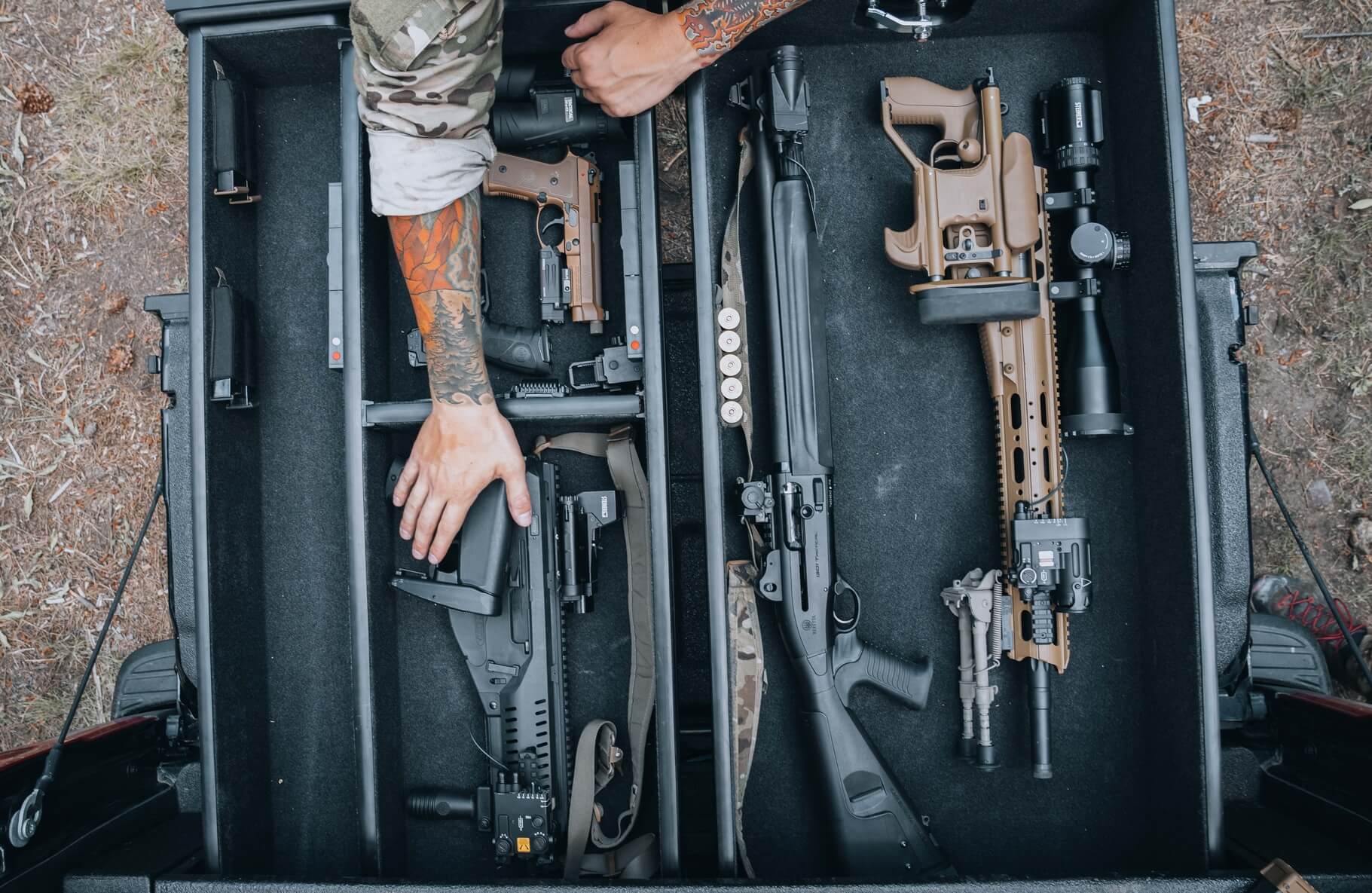
Primary weapon is a fundamental element to take into consideration. it may vary depending on the mission to accomplish, on the Operator’s role in the Team and on individual preferences and skills. It can be integrated with accessories such as:
- optics and lasers: red dot sights, holographic sights, or magnified scopes for improved target acquisition and accuracy;
- suppressors: attachment that reduce the noise and muzzle flash of firearms making it more difficult to locate the firer and allowing easier communication whilst engaging;
- vertical grips and bipods: accessories for better weapon control and stability during firing and maneuvering;
- sling Systems: adjustable slings to carry rifles securely and allow for quick transitions;
- backup & support weapon/s: also known as a secondary weapon or a backup firearm, is an additional weapon carried by military personnel as a contingency in case their primary weapon becomes inoperable, runs out of ammunition, or is otherwise unavailable. Support weapons such as non-lethal and breaching guns (Shotguns) may be additional to primary and secondary weapons. For more information, take a look to Benelli Defense.
- ammunition: it is an essential component of any firearm, providing the necessary propellant and projectiles for the weapon to function. The specific type of ammunition needed depends on the caliber, type, intended use and mission requirements, through our strategic alliance, BDT can propose specific ammunition to match any operational needs.
The integration of different components, -such as firearms, optics, and ammunition- into a cohesive platform, significantly enhance the overall combat effectiveness of the operator providing a force multiplier effect that enhances mission success. Through the BDT alliance, our companies propose integrated solutions combining their expertise, and develop integrable solutions that will interface with 3rd party solutions where needed.
3. Night Vision and Optics
Night vision and optics play a crucial role in enhancing vision and target acquisition capabilities in low-light or nighttime conditions. The Night vision technology allows users to see in conditions where there is insufficient natural light. It works by amplifying available light (image intensification) or converting infrared radiation into visible light. Devices can be found in various forms, including night vision goggles, monoculars, and weapon sights. Steiner Defense can give a clear overview about this. The image intensification technology differs from the Thermal imaging technology because this one detects the heat signatures emitted by objects and converts them into visible images. Thermal optics can operate in complete darkness, as they rely on the differences in temperature rather than available light. They are particularly effective for detecting heat sources, distinguishing targets from their surroundings, and operating in challenging environmental conditions.
Optics are particularly effective for aiming and target acquisition during both day and night operations. Optical sights and scopes, such as red dot sights, holographic sights, or magnified scopes, provide enhanced aiming capabilities by providing a clear reticle or crosshair for precise shot placement. These optics can be combined with night vision devices to create a comprehensive system for low-light engagements, and Rangefinders that measure the distance between the user and the target providing an accurate distance reading. Rangefinders are essential for determining target range, adjusting aiming points, and ensuring precise shots, particularly in long-range engagements. Advanced optics may feature built-in ballistic calculators or rangefinder integration ( e.g. the m7xi-ifs-4-28×56 ) which automatically adjust the aiming point based on target range, environmental factors, and ammunition ballistics. These calculators provide precise holdover or turret adjustments, simplifying the process of making accurate long-range shots.
4. Load-Bearing Equipment
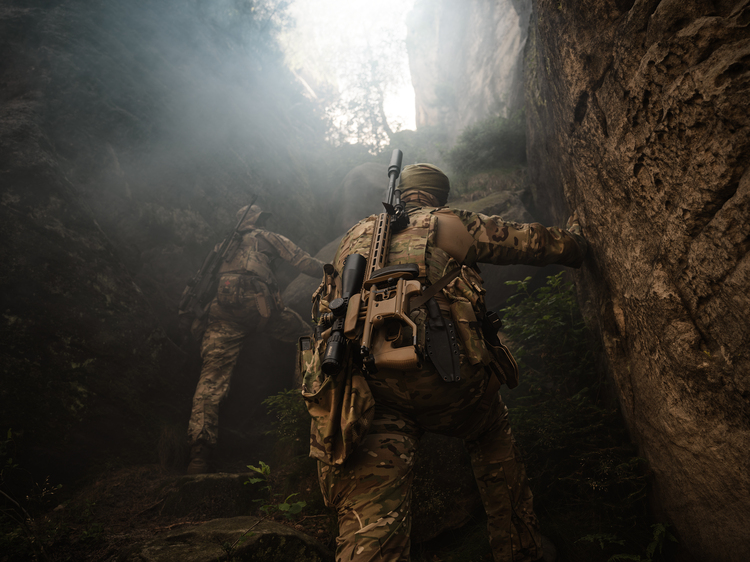
Load-bearing equipment provides the means to carry essential gear and equipment while maintaining mobility and operational effectiveness. Here are the main aspects of load-bearing equipment in modern warfare:
- modularity and customization: load-bearing equipment is designed to be modular, allowing operators to customize and configure the gear based on their specific mission requirements. This modularity enables them to adapt their loadout to various environments and operational scenarios;
- load carrying capacity: operators need to carry a significant amount of equipment, including weapons, ammunition, communication devices, medical supplies, survival gear, and more. Load-bearing equipment is designed to distribute the weight of this equipment evenly across the body, minimizing strain and fatigue on the operator;
- ergonomics and comfort: soldiers and Special forces operators often operate in extreme conditions and challenging environments for extended periods. Load-bearing equipment is designed to be ergonomic, ensuring a comfortable fit and reducing pressure points on the body. Padded shoulder straps, waist belts, and back panels with ventilation systems help to improve comfort during prolonged missions;
- durability and versatility: load-bearing equipment is built to withstand harsh conditions, rough handling, and intense physical activity. It is usually constructed from high-quality materials such as reinforced nylon or Cordura® fabric to provide excellent durability, water resistance, and resistance to abrasion;
- quick release mechanisms: in high-risk situations or emergencies, operators may need to rapidly shed their load-bearing equipment to maneuver or escape. Load-bearing systems often incorporate quick-release mechanisms, allowing operators to ditch their gear swiftly and efficiently when required.
- MOLLE (Modular Lightweight Load-carrying Equipment) System: the MOLLE system is a widely used attachment system in load-bearing equipment. It consists of rows of webbing on the gear, allowing operators to attach pouches, holsters, and accessories securely using specialized straps and clips;
- hydration systems: staying hydrated is crucial for operational performance and endurance. Many load-bearing equipment systems incorporate hydration systems, such as hydration bladders or water bottle pouches, enabling operators to carry and access water easily during missions without interrupting their tasks.
These aspects of load-bearing equipment are designed to enhance the operational capabilities of the Operator, allowing to carry his/her gear efficiently, stay comfortable during extended missions, and remain highly maneuverable and effective in various environments.
5. Tactical Clothing
It refers to specialized apparel designed for military personnel who requires functional and resistant footwear and clothing for tactical operations. Here are the main aspects of tactical clothing:
- durability: tactical clothing is built to withstand harsh conditions and frequent use. It is typically constructed from durable materials like ripstop nylon, Cordura®, or reinforced cotton to resist abrasion, tearing, and fading;
- functionality: tactical clothing is designed with functionality in mind, incorporating features that facilitate ease of movement, access to equipment, and versatility. These features can include articulated knees, gusseted crotches, and stretch panels to enhance mobility. Multiple pockets, cargo pockets, and hidden compartments provide storage options for essential gear and equipment.
- concealment and camouflage: tactical clothing often incorporates camouflage patterns or color schemes that blend with the operational environment, helping the operator to remain concealed and less visible. Camouflage patterns such as MultiCam, A-TACS, or digital camouflage are commonly used in tactical clothing. Also a ‘civilian’ profile of tactical clothing is a valuable option for low visibility/ covert operations.
- comfort: despite its durability, tactical clothing is designed to provide comfort during extended periods of wear. Moisture-wicking and breathable fabrics help regulate body temperature, while padded shoulders, adjustable cuffs, and waistbands enhance comfort and fit;
- protection: tactical clothing may offer enhanced protection features to mitigate potential risks in the field. This can include flame resistance, water resistance, and resistance to certain environmental hazards like insects or UV rays. Garments designed for specific roles, such as combat shirts or pants with integrated knee pads, offer additional protection and durability in critical areas;
- quick-drying and moisture management: tactical clothing is often designed to wick moisture away from the body and dry quickly to maintain comfort during intense physical activity. Fabrics with moisture-wicking properties help to keep the wearer dry and prevent the buildup of sweat, reducing the risk of discomfort or chafing.
- versatility: tactical clothing is typically designed to be versatile, suitable for a wide range of operational environments and conditions. Garments may have removable or adjustable components, such as hoods or sleeves, to adapt to changing weather conditions or mission requirements.
Tactical clothing is developed to meet the unique demands of professionals in high-stress and demanding situations, providing them with the necessary comfort, functionality, durability, and protection to perform their duties effectively.
6. Communication and Navigation
All Military forces require reliable communication systems to coordinate with their team members (INTRA) and command structure (INTER). These systems are:
- radios: portable communication devices for team coordination and situational awareness;
- GPS devices: navigation tools for accurate positioning, route planning, and waypoint marking;
- hadsets: tactical headsets with noise reduction and voice amplification for clear communication in noisy environments;
- compass: essential for land navigation and orientation.
7. Medical Equipment
Individual First Aid Kits (IFAK) are compact kits containing basic medical supplies for immediate treatment of injuries including airway management. The IFAK should be contained in a pouch/ pocket that is easily accessible by the operator and can be opened and deployed one handed. They are composed by:
- tourniquets and hemostatic agents: life-saving tools to control bleeding;
- stretchers: foldable or lightweight stretchers for casualty evacuation.
- medical pouches: Modular pouches for carrying medical supplies and equipment.
8. Survival and Outdoor Gear
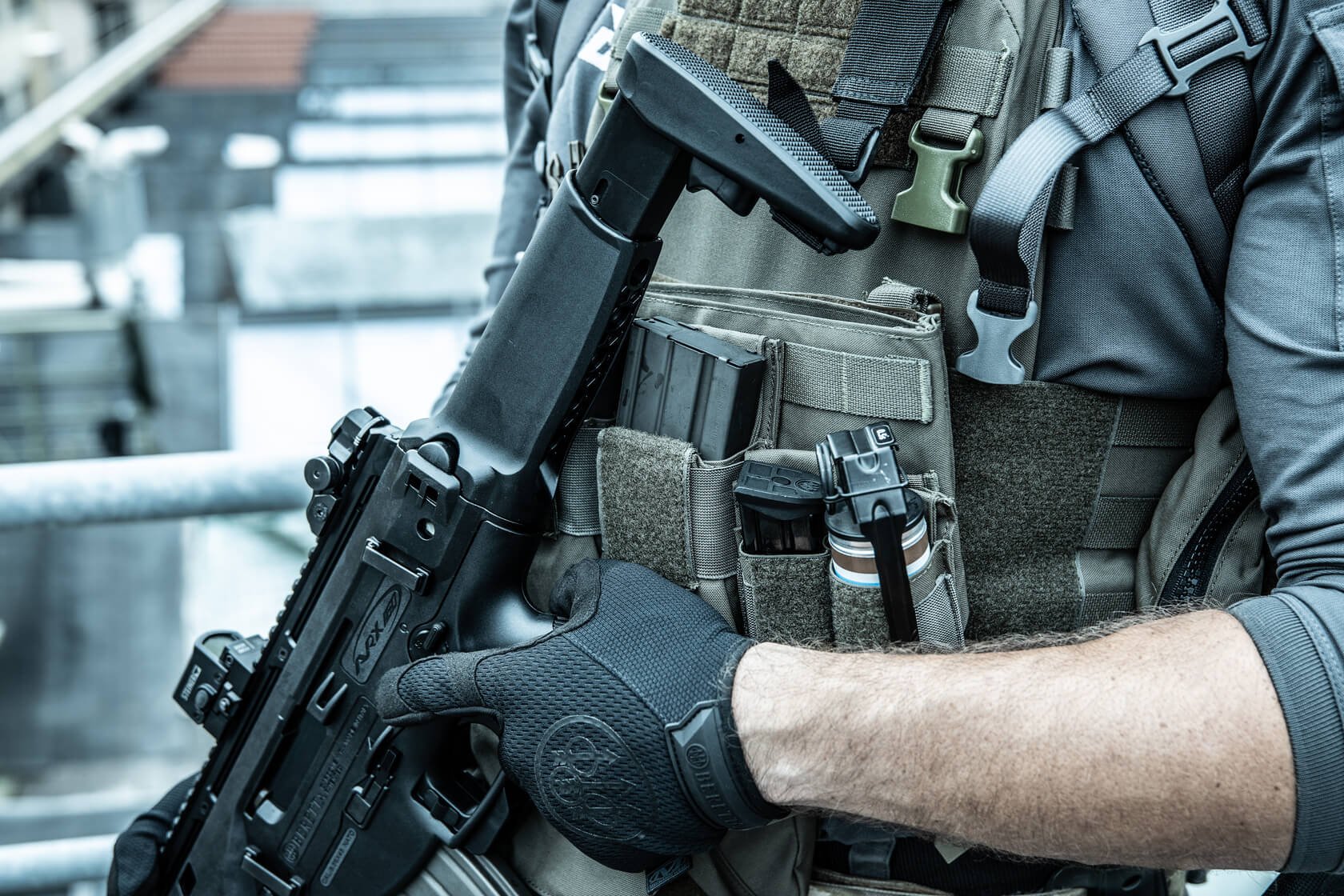
Survival and outdoor gears are tools used, as definition, for situazione in which a person has to face not ordinary scenarios. We can identify the following tools:
- multi-tools are versatile tools with various functions, including knives, bayonet, pliers, screwdrivers, and more;
- flashlights: powerful handheld/helmet-mounted or weapon-mounted lights for illumination during low-light situations;
- cable ties and duct tape: versatile supplies for equipment repairs and improvisation.
Most importantly, the military gear evolves over time, driven by current operation scenarios and modern warfare, as a result, advancements in technology and equipment are continuously being made. Industry must support development by offering the integration of technological and production improvements to deliver a cutting-edge capability. When selecting any tactical gear, always prioritize reliability, quality, and compatibility with your specific needs and mission requirements. BDT companies, globally renowned for decades of expertise and leadership in their respective fields, state of the art machinery and extensive R&D capabilities, they offer one of the most complete offerings in the industry, including accessories, wide range of firearms & ammunitions, optics and electro-optics as well as tactical clothing to provide the operator with the solutions needed to improve lethality, survivability, mobility, situational awareness, sustainability, training, and overall mission success, current and future.
Visit BDT to find more information.